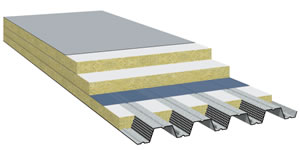In building envelope designs calling for high levels of acoustic performance, there is often a potential trade-off between the conflicting requirements for controlling sound reduction and sound absorption. Sound reduction refers to the control of either internal or external noise in a building.
Typical applications include concert venues, where one is trying to avoid excessive noise levels from breaking out and buildings in areas near noisy facilities, such as airports, where one strives to achieve precisely the opposite. Sound absorption is the more common acoustic feature required by designers.
It is the control of attenuation, or internal reverberation of sound against building surfaces. A school sports hall is a very typical, everyday application requiring attention. Although most projects usually require one method of acoustic control, some still need to address sound reduction and absorption in the same envelope construction.
A typical example would be a concert venue situated close to or underneath a flight path of a major airport and with nearby residential properties. Decks are typically perforated to break up sound waves and assist absorption. However the perforated open area also allows sound to escape into the roof cavity, thus lowering reduction values.
There may also be requirements of a project where longer spans are required and perforated deck is unsuitable.
How, then, can these conflicting requirements be achieved at a minimal cost?
The answer is to install a plain deck with a perforated under lining sheet, as indicated:-

Click to enlarge
Installation of a D159 plain roof deck provides maximum spanning capability, whilst the addition of RL32/1000 perforated liner enhances absorption values with a 22% open area, and provides a more aesthetically pleasing finish. Sound is absorbed into the trough infill fillets, as for a perforated deck profile. This liner may be installed directly below the deck, or positioned under the beams to hide all support structure.
Comparison of ex works prices, based on 1000m2, indicate that there is no additional cost increase, for profiled elements, by offering an underlining system.
There would be costs for supporting zed spacers, additional fasteners and installation time. However the combined benefits of enhanced acoustic absorption, reduction and aesthetics will more than justify the modest additional expense.




 Posted by karlstapleton
Posted by karlstapleton 


